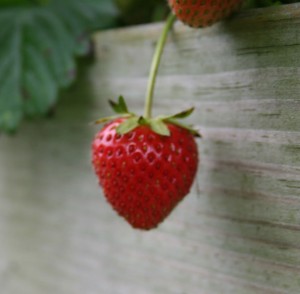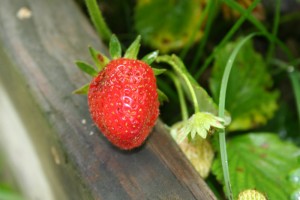Strawberries are truly one of the easiest small fruits to grow in the home garden. According to the North Carolina Cooperative Extension office, 25 strawberry plants can yield up to 50 pounds of berries in as little as one year. I’ve never had THAT good a harvest, but the berries I do pick (one is shown above, from last year) are sweet and so juicy they’re like eating candy.
Growing Strawberries
Strawberry plants need full, direct sunlight all day long, and rich, well-drained soil. My berry patch, as you can see in the photo above, is grown in a raised bed, but the great thing about growing strawberries is that you can grow them in pots, strawberry jars (special jars with pockets around the sides for multiple plants) or even window boxes. I saw a photograph online showing how old gutters, removed from a house, were filled with soil and planted with strawberry plants! You can use almost anything to grow strawberries.
Strawberry plants do not produce deep roots, so the trick is to keep them well-watered and fertilized during the growing season. This is one area where I apply not only compost, but a standard 10-10-10 fruit and vegetable fertilizer to my strawberry beds. I water daily during the hot weather, and cover the plants with pine straw mulch in the fall to protect them from frosts.
There are several types of strawberries to choose among for your garden. June-bearing plants produce larger fruits but only one crop, typically in June as the name implies. Ever-bearing can produce several crops in a season, but the berries tend to be a little smaller than average.
My own bed is planted with ever-bearing strawberry plants purchased from the local garden center. They produce their first berries starting in May, and I’m picking about one to two cups of berries several times a week until the end of June. A second flush of berries appears in late September.
However, the second crop is less than the first, and I’m fighting yellow jackets in the fall for the tender berries. I always get stung picking strawberries from my patch in the fall. I don’t want to scare you off from growing your own strawberries, but honestly, the nasty stinging yellow jackets are my nemesis in the berry patch in the fall.
Pests and Problems
I find that most insects leave the berries alone, although the Japanese beetles do attack the foliage somewhat. Crows are the worst offenders, often pecking at a juicy berry just when it’s ready to pick. Another problem I have is with squirrels. There’s one fat squirrel who slips over the fenced in garden to steal berries. He’s also the one who steals my peaches. No wonder he’s fat. The cats do an excellent job patrolling the area, but they do nap a lot during the day, and that’s when the crows and squirrels raid my berries.
You can buy bird netting to cover the beds. These nets keep animals and birds off of the berries but allow pollinating insects access to the flowers.
Propagation
Strawberry plants send out runners from the main plant or “mother” plant. Each runner roots itself in the ground, developing a ‘daughter’ plant. Over time, the mother plant may die back, leaving just the daughter plant. You can dig up the smaller plants and transplant them into new areas. I have to do this every few years.
My strawberry bed is now six years old, and the plants tend to cluster near the edges of the raised bed; the original plants were in nice, neat rows, but now the daughters have taken over, and the bed looks a little messy. If I’m going to transplant strawberry plants, I do it in April, and water them well to help them get settled before the hot Virginia summer arrives.
Storage
Strawberries freeze well, so if you find yourself picking a lot, you can cut off the caps and freeze them on baking sheets. After they’re frozen, place them in freezer bags, save, and enjoy throughout the year.
But truly, the best part of growing strawberries in the home garden is eating them picked directly from the plant. When you grow them organically, you don’t have to worry about washing them…just wipe the dirt off and bite into the sweet, juicy fruit. Throw the cap into the field to compost. That’s what I’m talking about…!







It took me a few years to rid my flower beds of strawberries that came from ‘I know not where’. And still I see them appear each year. I love strawberries, I just don’t want them in the flowers.
There was one place in NC where we used to buy the most delicious strawberries. Otherwise berries sold today are not sweet at all. When I was a kid you hardly needed to sweeten either strawberries or raspberries, not so today. I envy you being able to grow your own.
Guilie, thanks so much! I saw your profile and thought, “Hmmn…another one?” LOL! Really looking forward to getting to know you and your involvement with the dogs. Shadow waves a paw hello…
Jo, nice to see you! Our berries are really sweet but with a little tartness. I used to pile on the sugar on fresh strawberries when I was a kid, but no longer. I guess tastes change.
Hi Denise! I agree – strawberries in the flowers would be a pain in the neck! Thanks for dropping by.